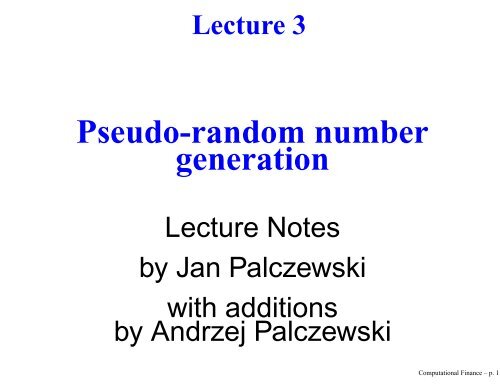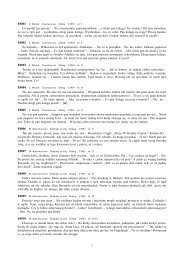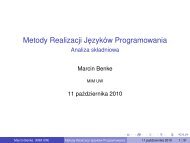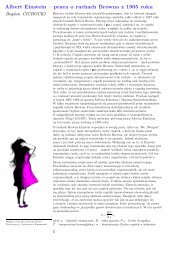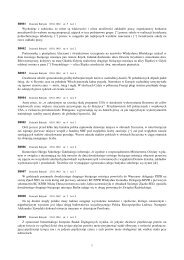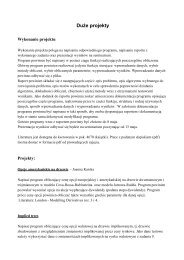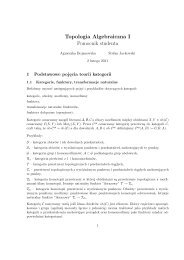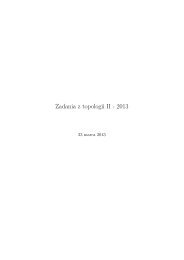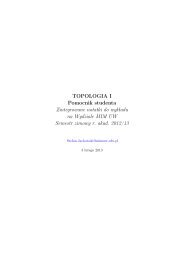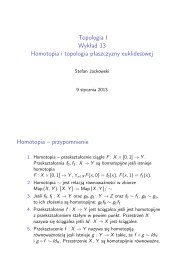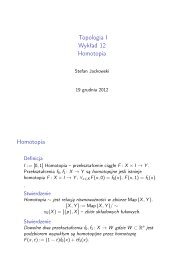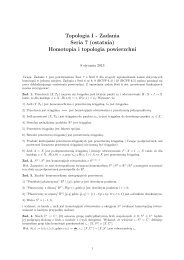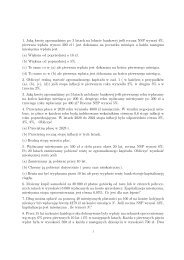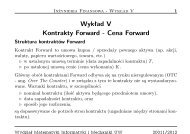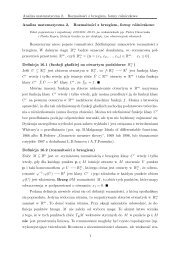Lecture 3 Pseudo-random number generation
Lecture 3 Pseudo-random number generation
Lecture 3 Pseudo-random number generation
You also want an ePaper? Increase the reach of your titles
YUMPU automatically turns print PDFs into web optimized ePapers that Google loves.
<strong>Lecture</strong> 3<br />
<strong>Pseudo</strong>-<strong>random</strong> <strong>number</strong><br />
<strong>generation</strong><br />
<strong>Lecture</strong> Notes<br />
by Jan Palczewski<br />
with additions<br />
by Andrzej Palczewski<br />
Computational Finance – p. 1
Congruential generator<br />
Define a sequence (si) recurrently<br />
Then<br />
si+1 = (asi + b) mod M.<br />
Ui = si<br />
M<br />
form an infinite sample from a uniform distribution on [0, 1].<br />
Computational Finance – p. 2
The <strong>number</strong>s si have the following properties:<br />
1. si ∈ {0, 1, 2,... ,M − 1}<br />
2. si are periodic with period < M. Indeed, since at least<br />
two values in {s0,s1,...,sM } must be identical, therefore<br />
si = si+p for some p ≤ M.<br />
In view of property 2 the <strong>number</strong> M should be as large as<br />
possible, because a small set of <strong>number</strong>s make the outcome<br />
easier to predict.<br />
But still p can be small even is M is large!<br />
Computational Finance – p. 3
5000 uniform variates<br />
a = 1229, b = 1, M = 2048, s0 = 1<br />
Computational Finance – p. 4
Are the <strong>number</strong>s Ui obtained with the congruential linear<br />
generator uniformly distributed? It seems so, as the histogram<br />
is quite flat.<br />
Does this really means, that the <strong>number</strong>s Ui are good uniform<br />
deviates?<br />
There is a question whether they are independent. To study<br />
this property we consider vectors built of Ui’s:<br />
(Ui,Ui+1,...,Ui+m−1) ∈ [0, 1] m<br />
and analyze them with respect to distribution.<br />
If Ui’s are good uniform deviates, above <strong>random</strong> vectors are<br />
uniformly distributed over [0, 1] m .<br />
It should be stressed that it is very difficult to assess <strong>random</strong><br />
<strong>number</strong> generators!<br />
Computational Finance – p. 5
The plot of pairs (Ui,Ui+1) for the linear congruential generator<br />
with a = 1229, b = 1, M = 2048.<br />
Computational Finance – p. 6
Good congruential generator with a = 1597, b = 51749 and<br />
M = 244944<br />
Computational Finance – p. 7
Deceptively good congruential generator with a = 2 16 + 3,<br />
b = 0, M = 2 31<br />
Computational Finance – p. 8
Apparently not so good congruential generator with<br />
a = 2 16 + 3, b = 0, M = 2 31<br />
Computational Finance – p. 9
In general Marsaglia showed that the m-tuples<br />
(Ui,...,Ui+m−1) generated with linear congruential generators<br />
lie on relatively low <strong>number</strong> of hyperplanes in R m .<br />
This is a major disadvantage of linear congruential generators.<br />
An alternative way to generate uniform deviates is by using<br />
Fibonacci generators.<br />
Computational Finance – p. 10
Fibonacci generators<br />
The original Fibonacci recursion motivates the following<br />
general approach to generate pseudo-<strong>random</strong> <strong>number</strong>s<br />
si = si−n op si−k.<br />
Here 0 < k < n are the lags and op can be one of the following<br />
operators:<br />
+ addition mod M,<br />
− subtraction mod M,<br />
∗ multiplication mod M.<br />
To initialize (seed) these generators we have to use another<br />
generator to supply first n <strong>number</strong>s s0, s1, . . . , sn−1. In<br />
addition, in subtraction generators we have to control that if<br />
si < 0 for some i the result has to be shifted si := si + M.<br />
Computational Finance – p. 11
What are ”good generators”?<br />
Good generators are those generators that pass a large<br />
<strong>number</strong> of statistical tests, see, e.g.,<br />
P. L’Ecuyer and R. Simard – TestU01: A C Library for Empirical Testing of Random Number<br />
Generators, ACM Transactions on Mathematical Software, Vol. 33, article 22, 2007<br />
TestU01 is a software library, implemented in C, and offering a<br />
collection of utilities for the empirical statistical testing of<br />
uniform <strong>random</strong> <strong>number</strong> generators.<br />
These tests are freely accessible on the web page<br />
http://www.iro.umontreal.ca/ simardr/testu01/tu01.html<br />
Computational Finance – p. 12
”Minimal Standard” generators<br />
W. H. Press, S. A. Teukolsky, W. T. Vetterling, B. P. Flannery – Numerical Recipes in C<br />
offers a <strong>number</strong> of portable <strong>random</strong> <strong>number</strong> generators, which<br />
passed all new theoretical tests, and have been used<br />
successfully.<br />
The simplest of these generators, called ran0, is a standard<br />
congruential generator<br />
si+1 = asi mod M,<br />
with a = 7 5 = 16807 and M = 2 31 − 1, is a basis for more<br />
advanced generators ran1 and ran2. There are also better<br />
generators like ran3 and ran4.<br />
Of these generators only ran3 possesses sufficiently good<br />
properties to be used in financial calculations.<br />
It can be difficult or impossible to implement these generators<br />
directly in a high-level language, since usually integer<br />
arithmetics is limited to 32 bits. Computational Finance – p. 13
To avoid this difficulty Schrage proposed an algorithm for<br />
multiplying two 32-bit integers modulo a 32-bit constant,<br />
without using any intermediates larger than 32 bits. Schrage’s<br />
algorithm is based on an approximate factorization of M<br />
M = aq + r, i.e. q = [M/a], r = M mod a.<br />
If r < q , and 0 < z < M − 1, it can be shown that both<br />
a(z mod q) and r[z/q] lie in the range [0,M − 1]. Then<br />
az mod M =<br />
�<br />
a(z mod q) − r[z/q], if it is ≥ 0,<br />
a(z mod q) − r[z/q] + M, otherwise.<br />
For ran0 Schrage’s algorithm is uses with the values<br />
q = 127773 and r = 2836.<br />
Computational Finance – p. 14
The Mersenne Twister<br />
The Mersenne Twister of Matsumoto and Nishimura which<br />
appeared in late 90-ties is now mostly used in financial<br />
simulations.<br />
It has a period of 2 19937 − 1 and the correlation effect is not<br />
observed for this generator up to dimension 625.<br />
Mersenne Twister is now implemented in most commercial<br />
packages. In particular, it is a standard generator in Matlab,<br />
Octave, R-project, S-plus.<br />
Computational Finance – p. 15
Generation of uniform<br />
pseudo-<strong>random</strong> <strong>number</strong>s<br />
The generator of pseudo-<strong>random</strong> <strong>number</strong>s with uniform<br />
distribution on interval [0, 1] in Octave can be called by one of<br />
the commands:<br />
rand (x)<br />
rand (n, m)<br />
rand ("state", v)<br />
The version rand (x) returns x-dimensional square matrix<br />
of uniformly distributed pseudo-<strong>random</strong> <strong>number</strong>s.<br />
For two scalar arguments, rand takes them to be the <strong>number</strong><br />
of rows and columns.<br />
Computational Finance – p. 16
The state of the <strong>random</strong> <strong>number</strong> generator can be queried<br />
using the form<br />
v = rand ("state")<br />
This returns a column vector v of length 625. Later, the<br />
<strong>random</strong> <strong>number</strong> generator can be restored to the state v using<br />
the form<br />
rand ("state", v)<br />
The state vector may be also initialized from an arbitrary<br />
vector of length ≤ 625 for v. By default, the generator is<br />
initialized from /dev/u<strong>random</strong> if it is available, otherwise from<br />
CPU time, wall clock time and the current fraction of a second.<br />
Computational Finance – p. 17
and includes a second <strong>random</strong> <strong>number</strong> generator, which<br />
was the previous generator used in Octave. If in some<br />
circumstances it is desirable to use the old generator, the<br />
keyword "seed" is used to specify that the old generator<br />
should be used.<br />
The generator in such situation has to be initialized as in<br />
rand ("seed", v)<br />
which sets the seed of the generator to v.<br />
It should be noted that most <strong>random</strong> <strong>number</strong> generators<br />
coming with C++ work fine, they are usually congruential<br />
generators, so you should be aware of their limitations.<br />
Computational Finance – p. 18
Generation of non-uniformly<br />
distributed <strong>random</strong> deviates<br />
Idea 1: Discrete distributions<br />
Idea 2: Inversion of the distribution function<br />
Idea 3: Transformation of <strong>random</strong> variables<br />
Computational Finance – p. 19
Idea 1: Discrete distributions<br />
Coin toss distribution: P(X = 1) = 0.5, P(X = 0) = 0.5<br />
(1) Generate U ∼ U(0, 1)<br />
(2) If U ≤ 0.5 then Z = 1, otherwise Z = 0<br />
Z has a coin toss distribution.<br />
Discrete distribution: P(X = ai) = pi, i = 1, 2,... ,n<br />
(1) Compute ck = � k<br />
i=1 pi<br />
(2) Generate U ∼ U(0, 1)<br />
(3) Find smallest k such that U ≤ ck. Put Z = ak<br />
Z has a given discrete distribution.<br />
Computational Finance – p. 20
Idea 2: Inversion of the distribution function<br />
Proposition. Let U ∼ U(0, 1) and F be a continuous and<br />
strictly increasing cumulative distribution function. Then<br />
F −1 (U) is a sample of F .<br />
Theoretically this approach seems to be fine. The only thing<br />
we really need to do is to generate uniformly distributed<br />
<strong>random</strong> <strong>number</strong>s.<br />
Works well for: exponential distribution, uniform distribution on<br />
various intervals, Cauchy distribution.<br />
Computational Finance – p. 21
Beasley-Springer-Moro algorithm for normal variate uses<br />
inversion of the distribution function with high accuracy<br />
(3 × 10 −9 ).<br />
In interval 0.5 ≤ y ≤ 0.92 the algorithm uses the formula<br />
F −1 (y) ≈<br />
and for y ≥ 0.92 the formula<br />
F −1 (y) ≈<br />
� 3<br />
n=0 an(y − 0.5) 2n+1<br />
1 + � 3<br />
n=0 bn(y − 0.5) 2n,<br />
8�<br />
n=0<br />
cn<br />
�<br />
log � − log(1 − y) �� n<br />
.<br />
Computational Finance – p. 22
Idea 3: Transformation of <strong>random</strong> variables<br />
Proposition. Let X be a <strong>random</strong> variable with density function<br />
f on the set A = {x ∈ R n |f(x) > 0}. Assume that the<br />
transformation h : A → B = h(A) is invertible and that the<br />
inverse h −1 is continuously differentiable. Then Y = h(X) has<br />
the density<br />
for all y ∈ B.<br />
y ↦→ f(h −1 (y)) ·<br />
�<br />
�<br />
�<br />
�det �<br />
dh−1 dy (y)<br />
��<br />
���<br />
,<br />
Computational Finance – p. 23
Multidimensional normal distribution N(µ, Σ) on R p has a<br />
density<br />
f(x) =<br />
1<br />
(2π) p/2<br />
1<br />
�<br />
exp<br />
(det Σ) 1/2<br />
− 1<br />
2 (x − µ)TΣ −1 �<br />
(x − µ) .<br />
Here µ is a p-dimensional vector of expected values, and Σ is<br />
a p × p-dimensional covariance matrix.<br />
Computational Finance – p. 24
If X ∼ N(µ, Σ), then<br />
X = (X1,X2,...,Xp),<br />
µ = EX = (EX1,...,EXp)<br />
Σ = (Σij)i,j=1,...,p is a square matrix, where<br />
Σij = Σji,<br />
Σii = var(Xi)<br />
Σij = cov(Xi,Xj) = E[(Xi − µi)(Xj − µj)]<br />
Computational Finance – p. 25
We are going to apply this result for the case where A = [0, 1] 2<br />
and f(x) = 1 for all x ∈ A (i.e. we start with a two-dimensional<br />
uniformly distributed <strong>random</strong> variable) and choose the<br />
transformation<br />
x ↦→ h(x) =<br />
�√−2 �<br />
ln x1 cos(2πx2),<br />
√<br />
−2 ln x1 sin(2πx2).<br />
The inverse of this transformation is given by<br />
y ↦→ h −1 �<br />
exp(−�y�<br />
(y) =<br />
2 �<br />
/2),<br />
arctan(y2/y1)/2π.<br />
Computational Finance – p. 26
We compute the determinant of the derivative at y = h(x) as<br />
follows:<br />
det<br />
�<br />
dh−1 dy (y)<br />
�<br />
= − 1<br />
2π exp<br />
�<br />
− 1<br />
2 (y2 1 + y 2 �<br />
2)<br />
Therefore, the density function of Y = h(X), where<br />
X ∼ U([0, 1] 2 ) equals<br />
f � h −1 (y) � ·<br />
� �<br />
� dh−1 � det<br />
dy (y)<br />
��<br />
��<br />
= 1 · 1<br />
2π exp<br />
�<br />
− 1<br />
2 (y2 1 + y 2 �<br />
2) .<br />
This is obviously the density function of the two-dimensional<br />
standard normal distribution.<br />
We therefore obtain that h(X) is 2-dimensional standard<br />
normally distributed, whenever X is uniformly distributed on<br />
[0, 1] 2 .<br />
Computational Finance – p. 27
Creates Z ∼ N(0, 1):<br />
Box-Muller algorithm<br />
1. Generate U1 ∼ U[0, 1] and U2 ∼ U[0, 1],<br />
2. θ = 2πU2, ρ = √ −2 log U1,<br />
3. Z1 := ρcos θ is a normal variate (as well as Z2 := ρsin θ).<br />
Computational Finance – p. 28
Box-Muller with congruential generator<br />
Computational Finance – p. 29
Naeve effect<br />
In 1973, H. R. Naeve discovered an undesirable interaction<br />
between simple multiplicative congruential pseudo-<strong>random</strong><br />
<strong>number</strong> generators and the Box-Muller algorithm. The pairs of<br />
points generated by the Box-Muller method fall into a small<br />
range (rectangle) around zero. The Naeve effect disappears<br />
for the polar method.<br />
Unfortunately, <strong>number</strong> theorists suspect that effects similar to<br />
the Naeve effect may occur for other pseudo-<strong>random</strong><br />
generators.<br />
In summary, since there are highly accurate algorithms for the<br />
inverse cumulative normal probability function, use those<br />
rather than the Box-Muller algorithm.<br />
Computational Finance – p. 30
Marsaglia algorithm<br />
The Box-Muller algorithm has been improved by Marsaglia in<br />
a way that the use of trigonometric functions can be avoided.<br />
It is important, since computation of trigonometric functions is<br />
very time-consuming.<br />
Algorithm: polar method (creates Z ∼ N(0, 1)):<br />
1. repeat generate U1,U2 ∼ U[0, 1];<br />
V1 = 2U1 − 1, V2 = 2U2 − 1;<br />
until W := V 2<br />
1 + V 2<br />
2 < 1.<br />
�<br />
2. Z1 := V1 −2 ln(W)/W<br />
�<br />
Z2 := V2 −2 ln(W)/W<br />
are both normal variates.<br />
Computational Finance – p. 31
Generation of N(µ,σ 2 ) distributed pseudo-<strong>random</strong><br />
variables<br />
(1) Compute Z ∼ N(0, 1)<br />
(2) Z1 = µ + σZ<br />
Z1 is a pseudo-<strong>random</strong> <strong>number</strong> from a normal distribution<br />
N(µ,σ 2 ).<br />
Computational Finance – p. 32
How to generate a sample from a multidimensional normal<br />
distribution?<br />
Theorem. Let Z be a vector of p independent <strong>random</strong><br />
variables each with a standard normal distribution N(0, 1).<br />
There exists a matrix A such that<br />
µ + AZ ∼ N(µ, Σ).<br />
Our aim is to find such a matrix A. We know how to generate<br />
a sequence of independent normally distributed <strong>random</strong><br />
variables. Using matrix A we can transform it into a sequence<br />
of multidimensional normal variates.<br />
Computational Finance – p. 33
The covariance matrix Σ is positive definite. One can show<br />
that there is exactly one lower-triangular matrix A with positive<br />
diagonal elements, s.t.<br />
Σ = A · A T ,<br />
where A T denotes a transpose of a matrix A.<br />
This decomposition is called the Cholesky decomposition.<br />
There are numerical methods how to compute the Cholesky<br />
decomposition of a positive definite matrix, but we don’t<br />
discuss this here.<br />
Computational Finance – p. 34
Algorithm for <strong>generation</strong> of N(µ, Σ) distributed pseudo-<strong>random</strong><br />
variables.<br />
1. Calculate the Cholesky decomposition AA T = Σ.<br />
2. Calculate Z ∼ N(0,I) componentwise by Zi ∼ N(0, 1),<br />
i = 1,...,n, for instance with Marsaglia polar algorithm.<br />
3. µ + AZ has the desired distribution ∼ N(µ, Σ).<br />
Computational Finance – p. 35
Constant correlation Brownian motion<br />
We call a process W(t) = (W1(t),...,Wd(t)) a standard<br />
d-dimensional Brownian motion when the coordinate<br />
processes Wi(t) are standard one-dimensional Brownian<br />
motions with Wi and Wj independent for i �= j.<br />
Let µ be a vector in R d and Σ an d × d positive definite matrix.<br />
We call a process X a Brownian motion with drift µ and<br />
covariance Σ if X has continuous sample paths and<br />
independent increments with<br />
X(t + s) − X(s) ∼ N(tµ,tΣ).<br />
Process X is called a constant correlation Brownian motion<br />
(which means that Σ is constant).<br />
Computational Finance – p. 36
Simulation<br />
For Monte Carlo simulations with correlated Brownian motion<br />
we have to know how to generate samples from N(δtµ,δtΣ).<br />
Since δt is a known constant we can reduce the problem to<br />
generating samples from distribution N(µ, Σ).<br />
Methods of sample <strong>generation</strong>:<br />
Cholesky decomposition (discussed earlier),<br />
PCA construction.<br />
Computational Finance – p. 37
Cholesky decomposition<br />
Algorithm for <strong>generation</strong> of N(µ, Σ) distributed pseudo-<strong>random</strong><br />
variables:<br />
1. Calculate the Cholesky decomposition AA T = Σ.<br />
2. Calculate Z ∼ N(0,I) componentwise by Zi ∼ N(0, 1),<br />
i = 1,...,n.<br />
3. µ + AZ has the desired distribution ∼ N(µ, Σ).<br />
Computational Finance – p. 38
PCA construction<br />
Principal Component Analysis (PCA) is the method of<br />
analyzing spectrum of the covariance matrix.<br />
Since Σ is symmetric positive definite matrix, it has d positive<br />
eigenvalues and d eigenvectors which span the space R d . In<br />
addition the following formula holds<br />
Σ = ΓΛΓ T ,<br />
where Γ is the matrix of d eigenvectors of Σ and Λ is the<br />
diagonal matrix of eigenvalues of Σ.<br />
Computational Finance – p. 39
Theorem. Let Z be a vector of d independent <strong>random</strong><br />
variables each with a standard normal distribution N(0, 1).<br />
Then<br />
µ + ΓΛ 1/2 Z ∼ N(µ, Σ),<br />
where Σ = ΓΛΓ T is the spectral decomposition of matrix Σ.<br />
Let us observe that due to positivity of eigenvalues Λ 1/2 is well<br />
defined.<br />
Computational Finance – p. 40
In general Cholesky decomposition and PCA construction do<br />
not give the same results.<br />
Indeed<br />
and<br />
holds. But in general<br />
Σ = AA T = ΓΛΓ T = ΓΛ 1/2 Λ 1/2 Γ T<br />
Σ(A T ) −1 = A = ΓΛ 1/2 Λ 1/2 Γ T (A T ) −1<br />
Λ 1/2 Γ T (A T ) −1 �= I,<br />
where I is the identity matrix. Hence<br />
AZ �= ΓΛ 1/2 Z<br />
even though both sides generate correlated deviates.<br />
Computational Finance – p. 41
Computer implementation<br />
In a Cholesky factorization matrix A is lower triangular. It<br />
makes calculations of AZ particularly convenient because it<br />
reduces the calculations complexity by a factor of 2 compared<br />
to the multiplication of Z by a full matrix ΓΛ 1/2 . In addition<br />
error propagates much slower in Cholesky factorization.<br />
Cholesky factorization is more suitable to numerical<br />
calculations than PCA.<br />
Why use PCA?<br />
The eigenvalues and eigenvectors of a covariance matrix have<br />
statistical interpretation that is some times useful. Examples<br />
of such a usefulness are in some variance reduction methods.<br />
Computational Finance – p. 42


